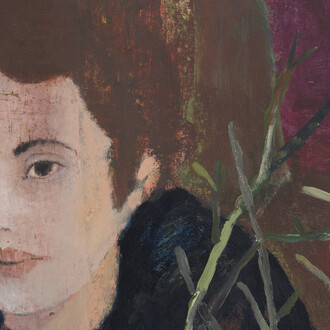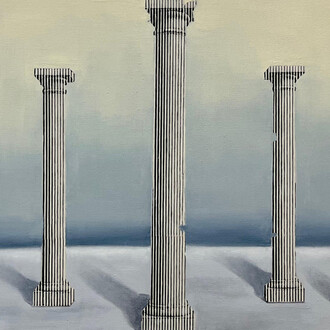The Ocean, long perceived as vast territory of adventure and freedom, is now the crucible for a globalized, overexploited, and polluted economy. For his first solo show at Galerie GP & N Vallois, Duke Riley takes us along on a trip through his maritime world, where the ocean is a vessel for the transmission of a modern and militant mythology in which legends, sailor tattoos, mistreated mermaids and an injured environment mingle.
In Baigné de vos langueurs, the American artist creates a dialogue between maritime folklore and ecological emergency. Each work becomes the fragment of a contemporary myth, where the sea, concurrently nurturing and jeopardized, serves as a guiding thread.
His series of mosaics, created from refuse recovered from the sea – plastic fragments, cigarette butts, lighters, seashells – first evoke artisanal compositions, whose symmetry and colors recall Latin American embroidery. However, as the gaze focuses, the beauty of the composition shatters: polluting materials supplant pearls and shells, like a visual fable on the transformation of oceans. In works such as Order from prescription history or Amoco Cadiz, Riley displays the duality: a seafaring aesthetic and the sullying of the waters, exhibiting a demoralizing truth.
Trained as a tattoo artist, Duke Riley continues to trace’ surfaces – no longer bodies, but trivial objects: bottles, flasks, cassette tapes, jerricans, hybrid artefacts loating on the ocean surface, materialized in the Poly S. Tyrene Memorial Maritime Museum series. As he employs the emblems of traditional tatooing:anchors, mermaids, ships, pierced hearts, these symbols take on political and poetic meanings. As though each object, retrieved from the waves, bore a new story, in the manner of scrimshaws, those whale bones engraved by whalers in the 19th century.
He extends this practice to paper, working on his compositions in the same way a tattoo artist prepares a motif before etching it into the skin. His past, intrinsically linked to his activism, permeates the entirety of his oeuvre.
With humor and gravitas, Duke Riley forges an ecological and popular mythology, feeding equally upon pop culture and maritime beliefs. His inventions summon the ghost of Popeye, as well as the dying echoes of a world suffocating beneath its own refuse. His works, both makeshift and precious, give new form to a lost folklore — that of a humanity once in dialogue with the sea, now faced with repairing its shipwrecks.
Duke Riley has presented solo exhibitions at the Brooklyn Museum, the Queens Museum of Art, the moCa Cleveland, the Havana Biennial, the Sydney Biennale, the Mercosul Biennial, and Philagrafika. More recently, he was the subject of a major retrospective at the Virginia Museum of Contemporary Art. His works are included in the permanent collections of the National Gallery of Art, the Whitney Museum, the Brooklyn Museum, and the Museum of Fine Arts, Boston. Riley divides his time between his studio at the Brooklyn Navy Yard – where he continues to raise pigeons – and a studio on a boat in Rhode Island, where he collects ocean plastic.
(Text by Hugo Poulaillon)














